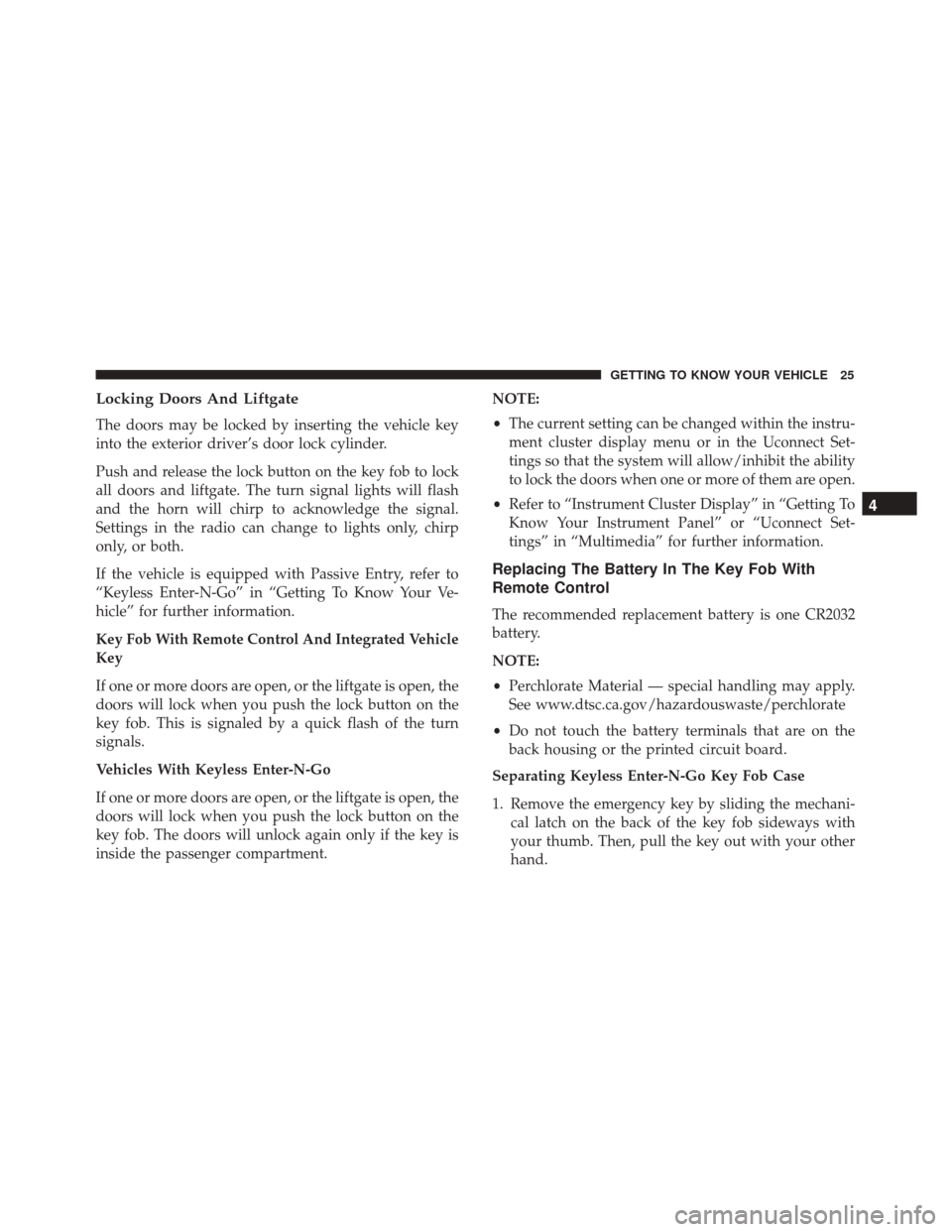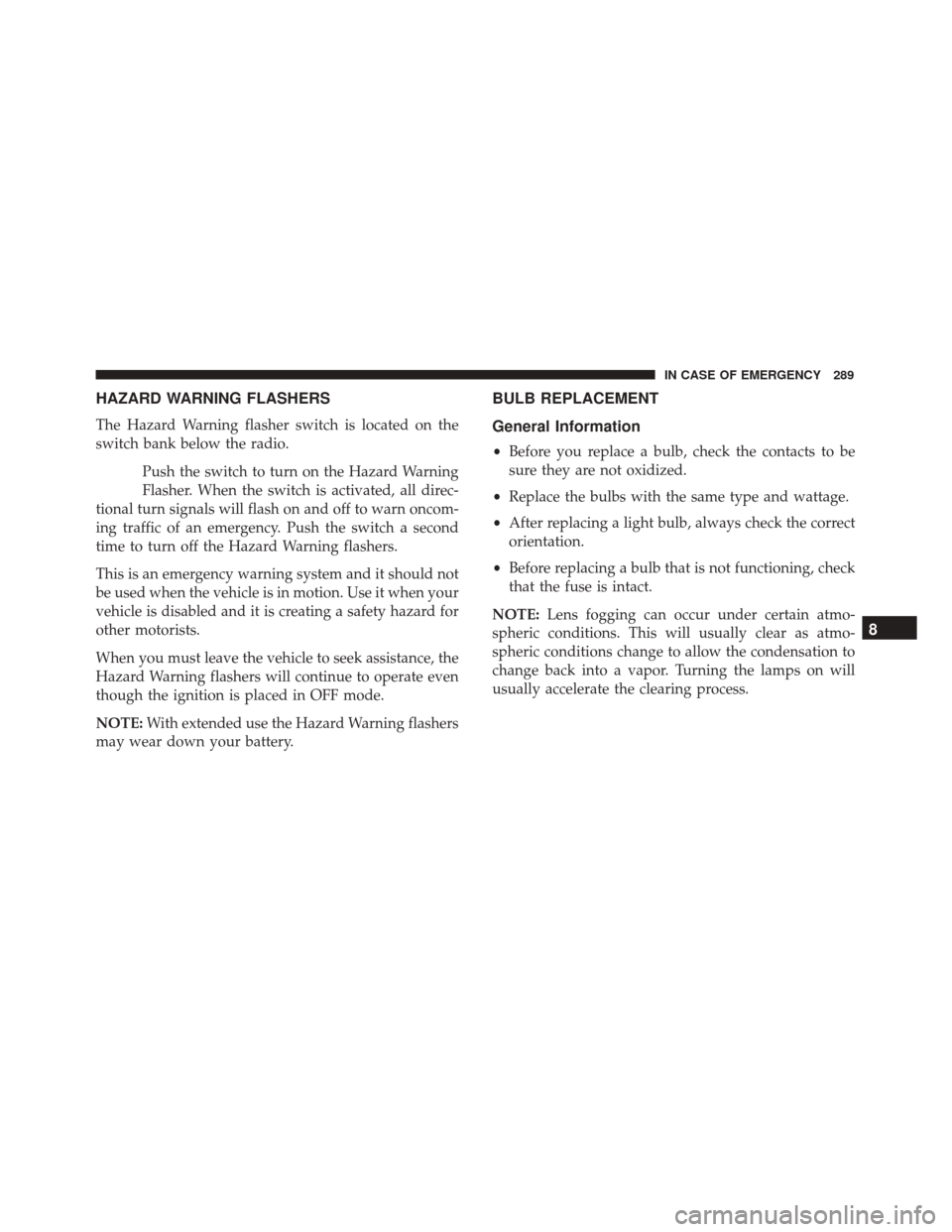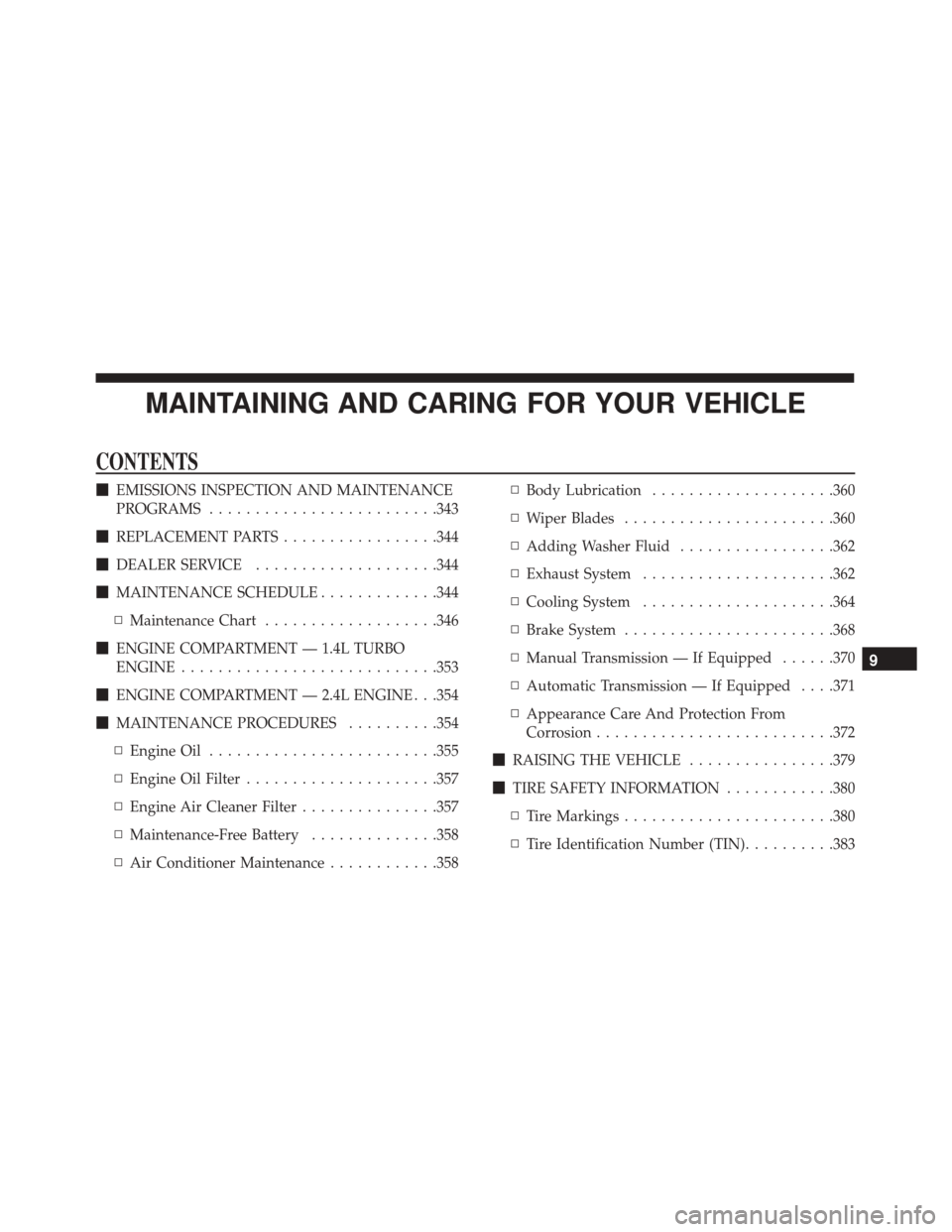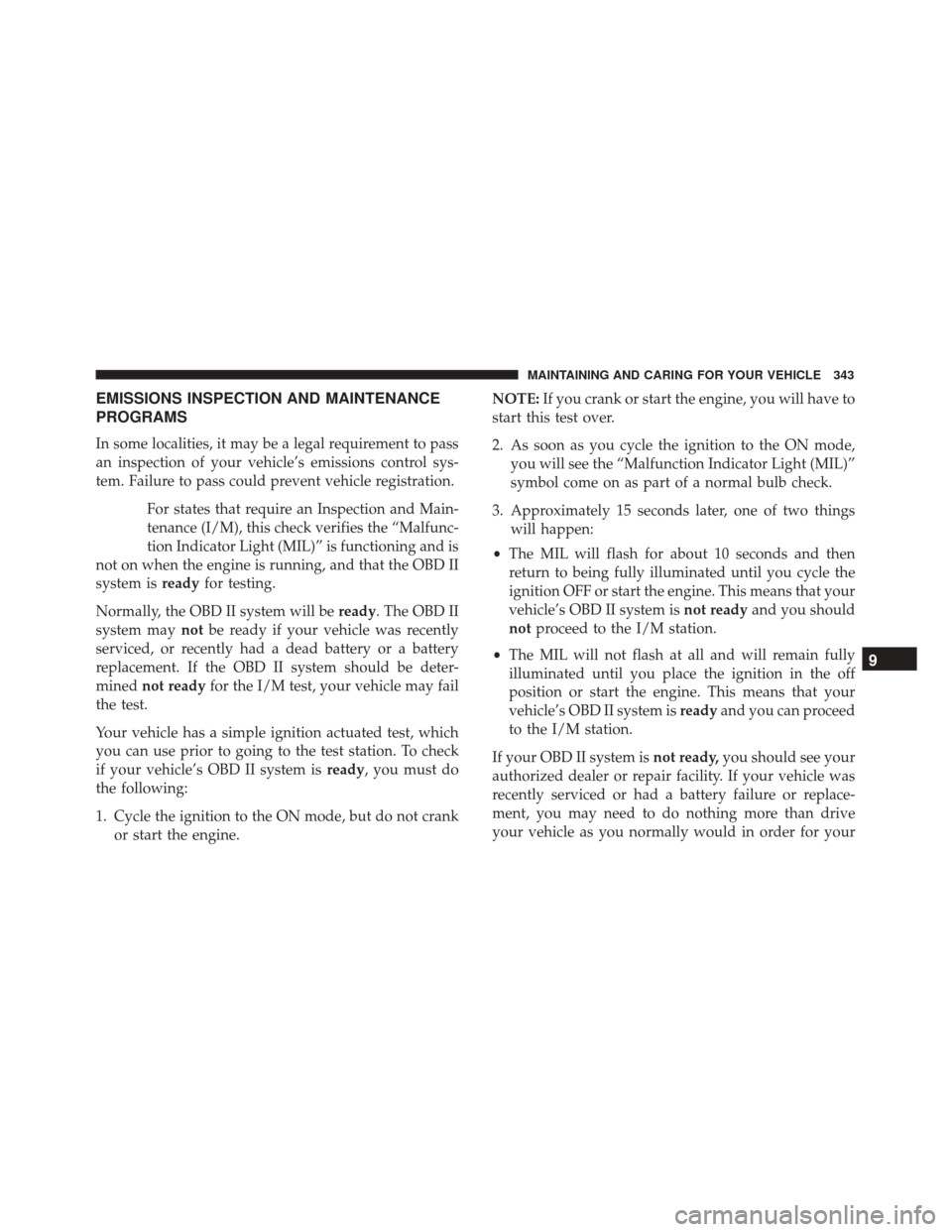Page 27 of 476

Locking Doors And Liftgate
The doors may be locked by inserting the vehicle key
into the exterior driver’s door lock cylinder.
Push and release the lock button on the key fob to lock
all doors and liftgate. The turn signal lights will flash
and the horn will chirp to acknowledge the signal.
Settings in the radio can change to lights only, chirp
only, or both.
If the vehicle is equipped with Passive Entry, refer to
“Keyless Enter-N-Go” in “Getting To Know Your Ve-
hicle” for further information.
Key Fob With Remote Control And Integrated Vehicle
Key
If one or more doors are open, or the liftgate is open, the
doors will lock when you push the lock button on the
key fob. This is signaled by a quick flash of the turn
signals.
Vehicles With Keyless Enter-N-Go
If one or more doors are open, or the liftgate is open, the
doors will lock when you push the lock button on the
key fob. The doors will unlock again only if the key is
inside the passenger compartment.NOTE:
•
The current setting can be changed within the instru-
ment cluster display menu or in the Uconnect Set-
tings so that the system will allow/inhibit the ability
to lock the doors when one or more of them are open.
• Refer to “Instrument Cluster Display” in “Getting To
Know Your Instrument Panel” or “Uconnect Set-
tings” in “Multimedia” for further information.
Replacing The Battery In The Key Fob With
Remote Control
The recommended replacement battery is one CR2032
battery.
NOTE:
• Perchlorate Material — special handling may apply.
See www.dtsc.ca.gov/hazardouswaste/perchlorate
• Do not touch the battery terminals that are on the
back housing or the printed circuit board.
Separating Keyless Enter-N-Go Key Fob Case
1. Remove the emergency key by sliding the mechani- cal latch on the back of the key fob sideways with
your thumb. Then, pull the key out with your other
hand.
4
GETTING TO KNOW YOUR VEHICLE 25
Page 291 of 476

HAZARD WARNING FLASHERS
The Hazard Warning flasher switch is located on the
switch bank below the radio.Push the switch to turn on the Hazard Warning
Flasher. When the switch is activated, all direc-
tional turn signals will flash on and off to warn oncom-
ing traffic of an emergency. Push the switch a second
time to turn off the Hazard Warning flashers.
This is an emergency warning system and it should not
be used when the vehicle is in motion. Use it when your
vehicle is disabled and it is creating a safety hazard for
other motorists.
When you must leave the vehicle to seek assistance, the
Hazard Warning flashers will continue to operate even
though the ignition is placed in OFF mode.
NOTE: With extended use the Hazard Warning flashers
may wear down your battery.
BULB REPLACEMENT
General Information
• Before you replace a bulb, check the contacts to be
sure they are not oxidized.
• Replace the bulbs with the same type and wattage.
• After replacing a light bulb, always check the correct
orientation.
• Before replacing a bulb that is not functioning, check
that the fuse is intact.
NOTE: Lens fogging can occur under certain atmo-
spheric conditions. This will usually clear as atmo-
spheric conditions change to allow the condensation to
change back into a vapor. Turning the lamps on will
usually accelerate the clearing process.
8
IN CASE OF EMERGENCY 289
Page 343 of 476

MAINTAINING AND CARING FOR YOUR VEHICLE
CONTENTS
�EMISSIONS INSPECTION AND MAINTENANCE
PROGRAMS ........................ .343
� REPLACEMENT PARTS .................344
� DEALER SERVICE ....................344
� MAINTENANCE SCHEDULE .............344
▫ Maintenance Chart ...................346
� ENGINE COMPARTMENT — 1.4L TURBO
ENGINE ........................... .353
� ENGINE COMPARTMENT — 2.4L ENGINE . . .354
� MAINTENANCE PROCEDURES ..........354
▫ Engine Oil ........................ .355
▫ Engine Oil Filter .....................357
▫ Engine Air Cleaner Filter ...............357
▫ Maintenance-Free Battery ..............358
▫ Air Conditioner Maintenance ............358▫
Body Lubrication ....................360
▫ Wiper Blades ...................... .360
▫ Adding Washer Fluid .................362
▫ Exhaust System .....................362
▫ Cooling System .....................364
▫ Brake System ...................... .368
▫ Manual Transmission — If Equipped ......370
▫ Automatic Transmission — If Equipped . . . .371
▫ Appearance Care And Protection From
Corrosion ......................... .372
� RAISING THE VEHICLE ................379
� TIRE SAFETY INFORMATION ............380
▫ Tire Markings ...................... .380
▫ Tire Identification Number (TIN) ..........383
9
Page 345 of 476

EMISSIONS INSPECTION AND MAINTENANCE
PROGRAMS
In some localities, it may be a legal requirement to pass
an inspection of your vehicle’s emissions control sys-
tem. Failure to pass could prevent vehicle registration.For states that require an Inspection and Main-
tenance (I/M), this check verifies the “Malfunc-
tion Indicator Light (MIL)” is functioning and is
not on when the engine is running, and that the OBD II
system is readyfor testing.
Normally, the OBD II system will be ready. The OBD II
system may notbe ready if your vehicle was recently
serviced, or recently had a dead battery or a battery
replacement. If the OBD II system should be deter-
mined not ready for the I/M test, your vehicle may fail
the test.
Your vehicle has a simple ignition actuated test, which
you can use prior to going to the test station. To check
if your vehicle’s OBD II system is ready, you must do
the following:
1. Cycle the ignition to the ON mode, but do not crank or start the engine. NOTE:
If you crank or start the engine, you will have to
start this test over.
2. As soon as you cycle the ignition to the ON mode, you will see the “Malfunction Indicator Light (MIL)”
symbol come on as part of a normal bulb check.
3. Approximately 15 seconds later, one of two things will happen:
• The MIL will flash for about 10 seconds and then
return to being fully illuminated until you cycle the
ignition OFF or start the engine. This means that your
vehicle’s OBD II system is not readyand you should
not proceed to the I/M station.
• The MIL will not flash at all and will remain fully
illuminated until you place the ignition in the off
position or start the engine. This means that your
vehicle’s OBD II system is readyand you can proceed
to the I/M station.
If your OBD II system is not ready,you should see your
authorized dealer or repair facility. If your vehicle was
recently serviced or had a battery failure or replace-
ment, you may need to do nothing more than drive
your vehicle as you normally would in order for your
9
MAINTAINING AND CARING FOR YOUR VEHICLE 343
Page 356 of 476
ENGINE COMPARTMENT — 2.4L ENGINE
MAINTENANCE PROCEDURES
The pages that follow contain therequiredmaintenance
services determined by the engineers who designed
your vehicle. Besides those maintenance items specified in the fixed
maintenance schedule, there are other components
which may require servicing or replacement in the
future.
1 — Engine Air Cleaner Filter
4 — Brake Fluid Reservoir7 — Washer Fluid Reservoir
2 — Engine Oil Dipstick 5 — Battery8 — Coolant Pressure Bottle Cap
3 — Engine Oil Fill Cap 6 — Power Distribution Center (Fuses) 9 — Coolant Pressure Bottle
354 MAINTAINING AND CARING FOR YOUR VEHICLE